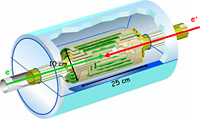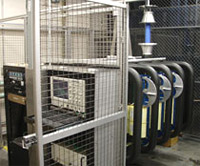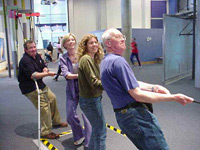The ILC Vertex Detector: Tagging Transient Particles

Possible geometry for the ILC vertex detector. |
At the heart of the massive ILC detector system, the vertex detector, a compact tracking device about the size of a wine bottle, surrounds the interaction region. This high-tech piece of equipment hosts about a billion pixels in total - equivalent to hundreds of the finest cameras. It works just like a 3-D camera because it measures the tracks of outgoing particles with micron precision. "Building and designing a vertex detector for the ILC is a real challenge," said Marc Winter, a physicist leading a micro-electronics group in IPHC, an IN2P3 Laboratory in Strasbourg, France. "This detector will reach fantastic performances, well beyond what was ever achieved so far."
Read more...
-- Perrine Royole-Degieux |
 |
|
|
 |
Upcoming meetings, conferences, workshops
 The 9th ACFA ILC Physics & Detector Workshop & ILC GDE Meeting The 9th ACFA ILC Physics & Detector Workshop & ILC GDE Meeting
IHEP, Beijing
4-7 February 2007
The LHC Early Phase for the ILC
Fermilab, Batavia, Illinois
12-14 April 2007
TESLA Technology Collaboration Meeting
Fermilab, Batavia, Illinois
23-26 April 2007
Annual WILGA Conference
Warsaw University of Technology Resort, Poland
21-27 May 2007
 LCWS 2007 LCWS 2007
Hamburg, Germany
30 May - 4 June 2007
VII International workshop on Problems of Charged Particle Accelerators: Electron-positron Colliders
JINR-BINP, Alushta (Crimea, Ukraine)
2-8 September 2007
IEEE EUROCON 2007
Warsaw, Poland
9-12 Sept 2007
12th International Workshop on Polarized Sources and Targets (PST 2007)
Brookhaven National Laboratory
10-14 September 2007
|
|
 = Collaboration-wide Meetings = Collaboration-wide Meetings
GDE Meetings Calendar |
|
|
 |
From SLAC Today: ILC's Marx Modulator

The prototype Marx modulator, designed and constructed at SLAC. |
The current design for the International Linear Collider (ILC) requires 576, 10-megawatt klystron tubes to supply microwave power along its 40 km linear accelerator. Each ILC klystron tube needs 120,000 volt, 140-ampere pulses, fired at a rate of five pulses per second. Each pulse delivers a total energy of more than 23 kilojoules—the kinetic energy of a 20 millimeter cannon shell.
The ILC Marx Modulator, a current R&D program at SLAC, eliminates the need for a massive transformer just before the klystron to raise the output voltage up to 100's of kilovolts. However, the high pulse energy of the ILC klystron would require a truly massive (and expensive) transformer—upwards of 6.5 tons.
Read more...
-- Greg Leyh |
 |
|
|
 |
Media Advisory
31 January 2007
International Committee for Future Accelerators to Deliver Update on Progress of the International Linear Collider, Thursday, February 8
The International Linear Collider is a proposed electron-positron collider. The Reference Design Report provides the first detailed technical snapshot of the ILC and includes a preliminary value estimate to obtain guidance for optimisation of both the design process and R&D during the engineering phase...
Read more... |
|
From Chicago Maroon
26 January 2007
Labs brace for budget freeze
University-managed Argonne National Laboratory and Fermi National Accelerator Laboratory are facing a federal funding shortfall that could severely hamper the progress of major projects, lead to employee layoffs, and prompt a month-long shutdown...
Read more... |
|
From NPR Science
26 January 2007
A Conversation about Particle Physics
Science Friday's guest host Joe Palca speaks with Jacobo Konigsberg, cospokesman for the CDF collaboration at Fermilab; Dave Barney, outreach coordinator for the CMS collaboration at CERN; and Barry Barish, director of the Global Design Effort for the proposed International Linear Collider. They talk about the Tevatron, the Large Hadron Collider, the ILC and the search for the Higgs boson...
Read more... | Listen... |
|
|
 |
 |
|
|
 |
The Evolving ILC Design: Push-Pull Detector Arrangement

A well- engineered modern "push-pull" system will let two sophisticated ILC detectors share a single interaction point. |
"The full realization of the scientific potential of the ILC argues for the construction and operation of two complementary detectors by two international collaborations." This statement comes from a chapter of the soon to be released ILC Detector Concept Report (DCR), and there are many arguments for having two detectors. They would maximise the scientific opportunities, give the opportunity to cross-check, and provide complementarity and reliability. The case is backed up by generations of successful historical examples in particle physics. Designing the ILC to accommodate two complementary detectors has been a fundamental precept of our design process. As we have optimised the ILC for cost–to-performance, we have made no changes that reduce the scope of the physics potential. In the beam delivery and detector areas, we have changed the crossing angle to
14 mrad to reduce risk and cost; we have reduced the muon shield to the calculated thickness while preserving the option of increasing the shielding if necessary; we have moved the detector assembly to the surface to ease scheduling issues, and finally this week the Executive Committee decided to go to a "push-pull" detector arrangement for our Reference Design.
Read more...
-- Barry Barish
Director's Corner Archive |
 |
|
|
 |
9th ACFA Workshop and GDE Meeting
The organisers of the Beijing workshop have just published the third Bulletin, including a useful map to print out and show to taxi drivers and information on shuttles and registration.
Read more...
Linear Collider Forum of America Meeting
The LCFOA will be holding their next meeting in Washington, DC on 28 February on Capitol Hill in the Rayburn House Office Building, room 2325. See agenda.
ILC-Related Preprints
hep-ph/0701197
23 Jan 2007
Dark Matter and Collider Phenomenology of Universal Extra Dimensions |
|

